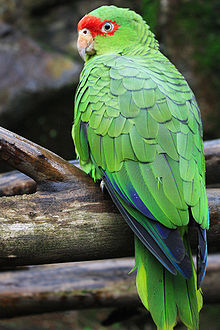Red-spectacled amazon
| Red-spectacled amazon | |
|---|---|

| |
| In Brazil | |
| Scientific classification | |
| Domain: | Eukaryota |
| Kingdom: | Animalia |
| Phylum: | Chordata |
| Class: | Aves |
| Order: | Psittaciformes |
| Family: | Psittacidae |
| Genus: | Amazona |
| Species: | A. pretrei
|
| Binomial name | |
| Amazona pretrei (Temminck, 1830)
| |

| |
The red-spectacled amazon (Amazona pretrei) is a species of parrot in the family Psittacidae. It is found in Argentina, Brazil, and Paraguay.
Its natural
The Red-spectacled Amazon migrates seasonally from the northern region of the state of
The species is distributed in the area of the frontier between southern Corrientes province in Argentina and the state of Rio Grande do Sul, Brazil.[4]
They are a quiet species with a relaxed disposition.[4]
Description

The red-spectacled amazon is 32 cm (13 in) long. It is mostly green with some sparse red spots on head, variable extent of red on forehead, lores and around eyes, white eyerings, red on the bend of the wings with blue tips to secondaries and primaries and yellowish bill.[5] Females have less red on the bend of the wing.[6]
Diet: 90 percent of the Red-spectacled amazon's diet that inhabits the wild contains Angustifolia seeds, those in captivity, their diets consist of vegetables along with Araucaria seeds.
Conservation and threats
The red-spectacled amazon is a declining species as it is highly threatened by the destruction of the Aruacaria moist forests and the illegal exotic pet trade.[7] An analysis of the extinct Amazona pretrei population records reveals that the species disappeared due to severe habitat loss, and in the past, the parrot's geographical range was at least 10% larger than the current range.[7]
The red-spectacled amazon is prized for its colorful feathers, mimicry ability, exotic appeal, and relative rarity, so eggs and live parrots are frequently smuggled from the wild and bred in captivity.[8] It is estimated that nearly 500 chicks are stolen from their nests and sold in Brazilian cities every year.[7]
References
- . Retrieved 12 November 2021.
- ^ "Appendices | CITES". cites.org. Retrieved 2022-01-14.
- ISSN 0006-3207.
- ^ PMID 29947677.
- ^ "Data Zone: Red-spectacled Amazon (Amazona pretrei)". BirdLife International. Retrieved 12 July 2020.
- ISBN 0-691-09251-6.
- ^ .
- PMID 27688959.

